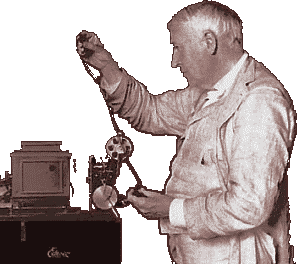




The invention of recorded sound by Thomas Edison in 1877 predated the successful demonstration of motion pictures by nearly 20 years. Edison and dozens of other prominent innovators in the motion picture field tried, without substantial results, to marry sound and picture. Without the aid of electrical amplification, sound motion pictures were limited to short loops viewed, and heard, by a single person in a Nickelodeon type of device called a Kinetophone which Edison developed from 1889 through 1893. The sound was recorded on an Edison cylinder and "loosely" synchronized with the picture. The practicality of the device can be measured by the number of units sold - zero.
In addition to work done by Edison, in France, Pathé introduced a disc based gramophone system similar to Edison's, called the "Berliner". A near identical system was also developed in Berlin by Oscar Messter, though he neglected to call it the "Parisian". Gaumont in France and Goldschmidt in Germany developed improved disc synchronization around 1900, but like all other experimental systems, there was no amplification to allow the sound to be reproduced to a theatre audience. Edison had tried banks of phonographs to achieve amplified sound, and we can only imagine how well synchronized a bank of ten phonographs must have been.
One of the more interesting schemes tried by various people in France, Germany, and America involved notching the edge of the film, (see exaggerated illustration at left), to create a sound record directly on the film. A stylus, acting much like a Victrola needle, would be moved by the passing rough edge of the film, which had been cut in a manner similar to the mastering of an original phonograph record. Exactly how the edge of the film was cut is unknown, but the system would have yielded poor sound that would degrade with every playing. None of the proposed edge cut systems was ever offered commercially.
From about 1908 to 1920, a number of people experimented with photographically recording sound on film. These systems met with limited technical success and commercial failure due to the inability to provide sound loud enough to be heard by more than a few people. Like any complex system, credit for the invention of sound motion pictures cannot be granted to any individual. However, the accumulated inventions of Lee De Forest (left), including the "Audion" tube which allowed amplification of electrical signals, were key to the development of both sound on film and sound on disc systems. DeForest's inventions were refined by companies like American Telephone & Telegraph and the Radio Corporation of America. De Forest, himself, was the first to successfully record sound on motion picture film in a process he called "Phonofilm".
Lee De Forest, known as the father of radio as a result of his invention of the Audion tube in 1906, poses in a 1922 photo with a strip of his Phonofilm sound-on-film.
De Forest's Phonofilm documents the sight and sound of Franklin D. Roosevelt placing Al Smith's name into nomination at the 1924 Democratic National Convention.
Above left, a title card from a trailer for an early talkie. Above right, a frame from the first story film with sound, Love's Sweet Old Song a two-reeler made in 1924 by De Forest. The attractive young lady is star Una Merkel.
De Forest materials saved from extinction by Maurice Zouary. The AFI Collection.
While it was his optical recording of sound on film in 1922 that was the first successful demonstration of talking pictures, it would be sound recorded on synchronized records that provided the impetus for the film industry to abandon silent pictures forever.
Sound Recording Principles Looking a bit like a thunderbolt thrown by the finger of Zeus, seen above is the waveform representing 1/1,000 of a second of Alan Jones singing Donkey Serenade for RCA Victor in the 1930's. While this image was generated in an AWSM computer from a digital sample, (haven't we come a long way?), peering through a microscope at the original record would reveal a groove of similar shape carved out of the shellac. We hope RCA won't press us for a royalty.
Any minute sample of sound contains two characteristics: loudness and pitch. In the sample seen above, variations in loudness are represented by how far the wave extends from the centerline. Pitch is determined by the frequency of the ripples, or how often they wiggle in a given period of time. High notes "wiggle" a lot and low notes "wiggle" less. Loud sounds have higher sustained peaks and softer sounds have lower sustained peaks. Total silence would yield a record groove that is perfectly straight and smooth. A normal sound will consist of many different frequencies, which would be represented by high frequency ripples on the low frequency wiggles. Now that's about as simple as I can make this.
Edison's cylinders were born in 1877 and gradually gave way to the phonograph disc. In the mid-1920's disc recording technology had existed for decades, but a method of recording sound as a photographic record on a piece of film was something that required a bit more finesse. Mr. DeForest's development of 1922 achieved that goal and, with substantial refinement, the technology is still in use today.